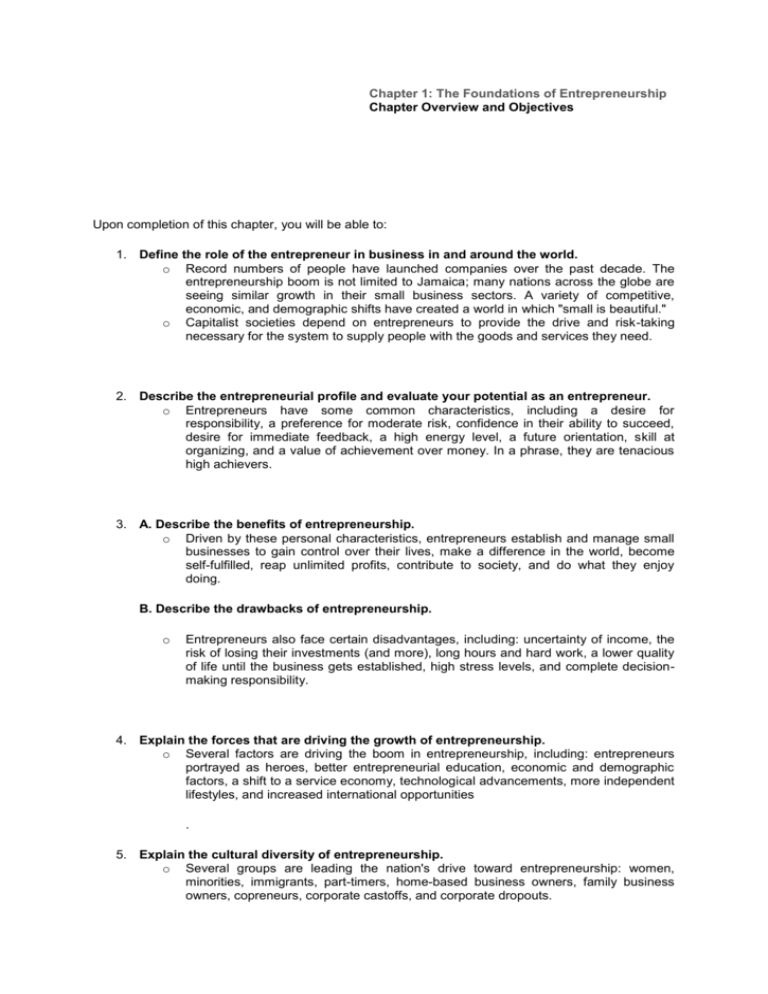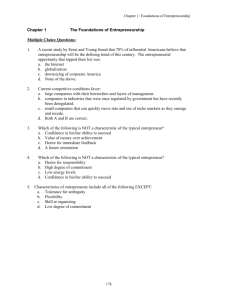UNIT I - The Foundations of Entrepreneurship
advertisement

Chapter 1: The Foundations of Entrepreneurship Chapter Overview and Objectives Upon completion of this chapter, you will be able to: 1. Define the role of the entrepreneur in business in and around the world. o Record numbers of people have launched companies over the past decade. The entrepreneurship boom is not limited to Jamaica; many nations across the globe are seeing similar growth in their small business sectors. A variety of competitive, economic, and demographic shifts have created a world in which "small is beautiful." o Capitalist societies depend on entrepreneurs to provide the drive and risk-taking necessary for the system to supply people with the goods and services they need. 2. Describe the entrepreneurial profile and evaluate your potential as an entrepreneur. o Entrepreneurs have some common characteristics, including a desire for responsibility, a preference for moderate risk, confidence in their ability to succeed, desire for immediate feedback, a high energy level, a future orientation, skill at organizing, and a value of achievement over money. In a phrase, they are tenacious high achievers. 3. A. Describe the benefits of entrepreneurship. o Driven by these personal characteristics, entrepreneurs establish and manage small businesses to gain control over their lives, make a difference in the world, become self-fulfilled, reap unlimited profits, contribute to society, and do what they enjoy doing. B. Describe the drawbacks of entrepreneurship. o Entrepreneurs also face certain disadvantages, including: uncertainty of income, the risk of losing their investments (and more), long hours and hard work, a lower quality of life until the business gets established, high stress levels, and complete decisionmaking responsibility. 4. Explain the forces that are driving the growth of entrepreneurship. o Several factors are driving the boom in entrepreneurship, including: entrepreneurs portrayed as heroes, better entrepreneurial education, economic and demographic factors, a shift to a service economy, technological advancements, more independent lifestyles, and increased international opportunities . 5. Explain the cultural diversity of entrepreneurship. o Several groups are leading the nation's drive toward entrepreneurship: women, minorities, immigrants, part-timers, home-based business owners, family business owners, copreneurs, corporate castoffs, and corporate dropouts. 6. Describe the important role small businesses play in our nation's economy. o The small business sector's contributions are many. They make up 99 percent of all businesses, employ 53 percent of the private sector workforce, have created 85 percent of the jobs since the early 1990s, produce 51 percent of the cx`ountry's private gross domestic product (GDP), and account for 47 percent of all business sales. 7. Describe the nine deadly mistakes of entrepreneurship. o There are no guarantees that the business will make a profit or even survive. SBA statistics show that 63 percent of new businesses will fail within 6 years. The nine deadly mistakes of entrepreneurship include incompetent management, lack of experience, poor financial control, failure to develop a strategic plan, uncontrolled growth, poor location, lack of inventory control, incorrect pricing, and inability to make the "entrepreneurial transition." 8. Put failure into the proper perspective. o Entrepreneurs recognize that failure is a natural part of the creative process. Successful entrepreneurs have the attitude that failures are simply stepping stones along the path to success, and they refuse to be paralyzed by a fear of failure. 9. Explain how entrepreneurs can avoid becoming another business failure statistic. o Entrepreneurs can employ several general tactics to avoid these pitfalls. Entrepreneurs should know their businesses in depth, prepare a solid business plan, manage financial resources effectively, understand financial statements, learn to manage people, and try to stay healthy.










